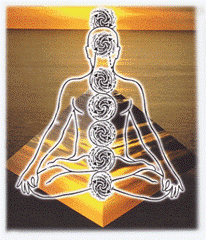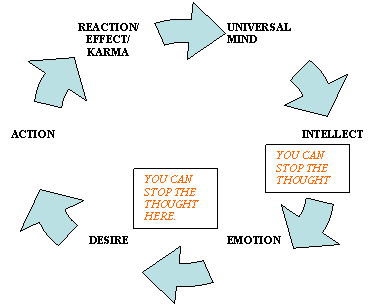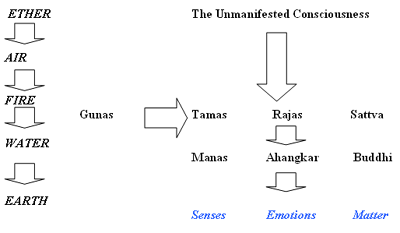
It is said that the mind is our best friend and our worst enemy. It’s amazing to observe how much suffering we create in our lives because we have no knowledge of how our mind works.
There have been many people dedicated to the study of the mind who have left a precious legacy behind them. But even with all that, for most people it remains as just knowledge without the possibility to put it into practice in their daily lives.
 If you look at a crowd of people in an airport, in a busy city or just passing by, they all seem to be immersed in their thoughts. Many of us have seen people talking aloud to themselves and we hope we never become like them, but the reality of it is that we do the same, we just don’t do it loudly or, for the most part, we keep it inside of our head.
If you look at a crowd of people in an airport, in a busy city or just passing by, they all seem to be immersed in their thoughts. Many of us have seen people talking aloud to themselves and we hope we never become like them, but the reality of it is that we do the same, we just don’t do it loudly or, for the most part, we keep it inside of our head.
What has happened to us? It seems that the mind has taken over. Our best ally has become our worst enemy. The fact that most people experience a constant flow of thoughts doesn’t mean that it is normal. It’ seems to be like a global sickness.
One or two generations before us, like the generation of our grandparents, except in extraordinary cases, they never thought of the fact that we are not our mind. They never thought of the possibility of silence of the mind. We have been so attached to the mind that we believe we are the mind.
 It is said that when you have a relationship with your mind you are in charge of all of its projections and facets. However without any connection, the mind speaks to you by sending different thoughts that can make one weak, ineffective and confused, thoughts like, “You sound good, actually you sound bad. You lack confidence. You are wrong. You must be right”, and so on. Who is the judge? Does that mean we are all that? No. It is just a stream of thoughts and senses under social pressure. When this happens your words start to lose impact, coherence and depth. Based on these thoughts, one starts actions. These actions create results or reactions, which we may not be prepared to face.
It is said that when you have a relationship with your mind you are in charge of all of its projections and facets. However without any connection, the mind speaks to you by sending different thoughts that can make one weak, ineffective and confused, thoughts like, “You sound good, actually you sound bad. You lack confidence. You are wrong. You must be right”, and so on. Who is the judge? Does that mean we are all that? No. It is just a stream of thoughts and senses under social pressure. When this happens your words start to lose impact, coherence and depth. Based on these thoughts, one starts actions. These actions create results or reactions, which we may not be prepared to face.
 We become a yo-yo of old patterns of conduct, the thousands of old habits that rule the psyche and then us. The mind has the capacity to act like a recorder that automatically activates our behaviors, feelings and thoughts. And there you are again, acting and reacting to the results of your actions. Like caught in a game with no relationship to the mind, or understanding of what is happening to you.
We become a yo-yo of old patterns of conduct, the thousands of old habits that rule the psyche and then us. The mind has the capacity to act like a recorder that automatically activates our behaviors, feelings and thoughts. And there you are again, acting and reacting to the results of your actions. Like caught in a game with no relationship to the mind, or understanding of what is happening to you.
How can we develop a relationship with the mind? How can we bring the mind to neutral, to zero, to silence? That is why we meditate.
 Let’s talk about how the mind works. Based on the teachings of Yogi Bhajan, the pattern of thought follows a defined path.
Let’s talk about how the mind works. Based on the teachings of Yogi Bhajan, the pattern of thought follows a defined path.
It begins when the intellect releases a thought. That thought goes through the mind and its attachments, habits and past experiences, creating an emotion. This emotion will create a desire to make it happen, and this desire will leads us to an action. In the polarity we live, every action creates a reaction or karma, and the wheel keeps spinning with more, and more thoughts generated by that original thought.
There are two specific points where you can consciously stop the wheel. If you do not stop the thought there, then the ball of thoughts will keep spinning leaving you at the complete mercy of your mind.
One of them is at the point between emotion and desire, where you can attach or detach yourself from that specific thought. For an emotion to become desire it needs to have added a personal attachment.
The other point where you can stop engaging in that particular thought is at is origin, at the point between the intellect and the thought. If you apply the mind at this point, the mind will surrender the intrigues around the thought, and you will be able to perceive the thought as what it really is.

This is a basic understanding of the mind, but if you want to change feelings, habits, and attitude it’s important to understand the interaction between the three functional minds (Negative, Positive, and Neutral minds) and the three impersonal minds (buddhi, ahangkar, and manas).
 There are three steps in the thought process. The firsts step in the thought process is the Negative Mind. Its function is to protect us. It tells us what can happen to us in any situation. For example, if we are driving a car and we are going way too fast, it will tell us we can have an accident. It acts as a protective mechanism. The second step in the thought process is the Positive Mind. It tells you what can be useful or right about the same thought. It sees all the possibilities a situation can bring to you. It doesn’t see the dangers or problems that may arise, just the many possibilities. The third and last step in the thought process is the Neutral Mind. Its function is to come up with the best result for you based on your goal, and the information provided by the Negative and Positive minds, but without leaning more in one or the other.
There are three steps in the thought process. The firsts step in the thought process is the Negative Mind. Its function is to protect us. It tells us what can happen to us in any situation. For example, if we are driving a car and we are going way too fast, it will tell us we can have an accident. It acts as a protective mechanism. The second step in the thought process is the Positive Mind. It tells you what can be useful or right about the same thought. It sees all the possibilities a situation can bring to you. It doesn’t see the dangers or problems that may arise, just the many possibilities. The third and last step in the thought process is the Neutral Mind. Its function is to come up with the best result for you based on your goal, and the information provided by the Negative and Positive minds, but without leaning more in one or the other.
The problem is that often our mind is clogged by the many thoughts it releases. The thought may never reach the Neutral mind and it may get distorted in the Positive mind. When the Negative mind releases a thought, normally the Positive mind should tell you what that thought is useful for and contrast and compare it. However, if the mind is full of subconscious thoughts, instead of contrasting the thought it will expand it by pulling information from the subconscious memory to support that thought.
For example the mind can say, this same thing happen yesterday, and it was also risky in 1965, 1973, 1981, etc. The more information it finds to support that thought, the more intense it becomes and it will never reach the Neutral mind.
9999
 “You must develop the mind, through meditation, to give you the positive of the negative and the negative of the positive, so that by your own grace and consciousness you can find the neutral of it.”—Yogi Bhajan
“You must develop the mind, through meditation, to give you the positive of the negative and the negative of the positive, so that by your own grace and consciousness you can find the neutral of it.”—Yogi Bhajan
Some people have a strong Positive mind, others may have a stronger Negative mind, or Neutral mind. We need all of them in order to act effectively in the different situations we may encounter.
The Negative Mind will make you act in a defensive, protective way. The Positive mind will encourage you to take an action. And the Neutral mind will analyze it.
The mind is governed by the following three basic qualities called gunas: Sattva, the pure, neutral, subtle and sublime quality; Tamas, confused, slow, contaminated quality; and Rajas, fiery, active, and transformative. Rajas transforms Tamas to Sattva, and Sattva to Tamas. The three qualities of the gunas intermingle, combine and contrast constantly. They also work with the vast ocean of the Universal mind called chitta which is then divided into three major functions that reflect the gunas.
Sattva guna is represented by buddhi which separates what is real from unreal. It represents totality as totality.
Rajas guna is represented by ahangkar which gives the sense of ego, boundaries and attachment.
 Tamas guna is represented by manas or sensory mind. It stores feelings, sounds, images, subconscious reactions, etc.
Tamas guna is represented by manas or sensory mind. It stores feelings, sounds, images, subconscious reactions, etc.
The tattvas (ether, air, fire, water, earth) give senses, actions, and perceptions to the mind. They blend with the activity of the gunas, as well as the buddhi, ahangkar and manas qualities of the mind.

Each thought produces feelings and emotions, resulting in desires which then produce actions. Each though has is own dimensions, structure and visual form. When we react to the structure of a thought, we gain control over the thought. As such, we can choose to act or to block it. However, when we do not recognize the thought as what it really is, we get caught in the wheel of that thought.
 The intellect releases thoughts constantly and the mind releases thoughts that will support the intention. The mind has attachments, actions and reactions based on past experiences.
The intellect releases thoughts constantly and the mind releases thoughts that will support the intention. The mind has attachments, actions and reactions based on past experiences.
When a thought is released, it interacts with a total of 81 facets of the mind. This number comes from the combination between the three functional minds (the Negative, Positive and Neutral minds) with the impersonal minds (manas, ahangkar, and buddhi). This creates 9 aspects or archetypes. All are needed. They will determine how you will choose to react based on a specific situation, depending on which mind is stronger. This varies depending on the person.
The functional minds will react again with the 9 aspects, creating 27 projections. Then the functional mind will react one last time with the 27 projections, creating 81 facets.
 This will determinate the action you will take in a specific situation, to run away, be still or fight for example. There is a meditation given by my teacher Yogi Bhajan to balance each of the 9 aspects, and there are 27 meditations to balance each of the 27 projections. This will allow you to get a grip of your mind and make it work for you so that you can stop being a yo-yo of your emotions and experience your birthright – happiness.
This will determinate the action you will take in a specific situation, to run away, be still or fight for example. There is a meditation given by my teacher Yogi Bhajan to balance each of the 9 aspects, and there are 27 meditations to balance each of the 27 projections. This will allow you to get a grip of your mind and make it work for you so that you can stop being a yo-yo of your emotions and experience your birthright – happiness.
Yogi Bhajan said that the mind will be totally understood in a thousand years from now. (Of course, I don’t have the information about which year he said that). He also said that that will be the beginning of the end of all suffering.
This article was based on the teachings of Yogi Bhajan with the intention of expanding his teachings so that they can reach more and more people and improve the quality of their lives.
 For all of the meditations in this subject, you can ask for the guidance of your teacher or, if you don’t have a Kundalini Yoga teacher, you can contact a certified Kundalini Yoga teacher in your area. We have a pretty good teacher’s directory at www.3ho.org. Another option is to buy the book written on this subject called “The mind” by Yogi Bhajan and Gurucharan Singh Khalsa, which is a jewel in my opinion.
For all of the meditations in this subject, you can ask for the guidance of your teacher or, if you don’t have a Kundalini Yoga teacher, you can contact a certified Kundalini Yoga teacher in your area. We have a pretty good teacher’s directory at www.3ho.org. Another option is to buy the book written on this subject called “The mind” by Yogi Bhajan and Gurucharan Singh Khalsa, which is a jewel in my opinion.
Sat Nam,
Indra Kaur
- February 2007 – Sexuality and Spirituality
- March 2007 – Detoxify Your Body
- April 2007 – Vibrations and Mantras
- May 2007 – Yoga exercises to Loss Weight, cleanses & recipes
- June 2007 – Sadhana, Aradhana, Prabhupati & Amazing Yogis & Fabulous Yoga Workshops
- July 2007 – Spiritual Beings Having A Human Experience
- August 2007 – Happiness
- September 2007 – The Mind
- October 2007 – One day in “MINDFULNESS”
- November 2007 – I Always Want More
- January 2008 – News exciting
- March 2008 – Oneness
- August 2008 – Summer
- September 2008 – Fall
- December 2008 – Winter
- March 2009 – Spring
- April 2009 – Newsletter
- May 2009 – Relaxation Techniques
- June 2009 – Learn to Meditate
- July 2009 – Inspiration
- September 2009 – Men’s Yoga
- October 2009 – Chakras
- December 2009 – The Light Within
- January 2010 – Living An Empty Life
- February 2010 – Our Essence
- May 2010 – Konalani Sharanam
- November 2010 – Osho’s Awakening – by Osho
- December 2012 – The Shift
- February 2013 – TANTRIC SEX
